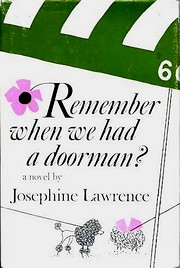
You probably couldn’t find a more resolutely practical novelist than Josephine Lawrence. In the 30-plus adult novels she wrote between 1932 and 1975, she consistently wrote about people coping with problems of everyday life: growing old, growing up, dealing with children and aging parents, trying to make ends meet, getting laid off, finding a decent house to live in, figuring out how to get along with annoying neighbors, figuring out whether the person you’ve been going with for the last two years is the one you’re supposed to marry.
Partly this may be due to the fact that she spent a few years writing “Question and Answer,” an early advice column ala “Dear Abby” that appeared in the Newark Sunday Call. Coming early in her career, this experience put her in touch with the dilemmas of her readers, and these became the vein she mined for over forty years at the rate of a book every fifteen months.
In the case of A Tower of Steel, the problems revolved around the fact that the United States had entered a war, enlisting or drafting millions of men, consuming precious resources, and leaving many of the non-combatants in an odd sort of limbo. Marsh Lyman, well into his seventies (his staff call him “the Old Man”), has to hold off on retirement while he keeps the law firm of Lyman, Lyman, Lyman, and Lyman going in the absence of his three nephews and partners, all serving in uniform.
… the silence of the room in which she and the Old Man sat had in it a curious quality of pressure or of waiting. That oppressive heaviness, suffocating, labored, shutting them away from reality, extended, she fancied, beyond the closed door. those other silent offices, empty except for shadows, pulled constantly at the Old Man’s thoughts. He looked in each one every morning, had instructed Mrs. Mullane to clean and dust them. The rooms waited, he waited, and it was the struggle not to let life stop, not to listen to the silence, that weighted the quiet atmosphere.
Supporting him is a staff of four women, each dealing with one or other of the challenges of life. Thalia, Marsh’s experienced and capable secretary, endures living with a rough-and-tumble extended family sharing a ramshackle house with just one bathroom. Frannie, the office manager, tries to stay ahead of a shopaholic mother coming out of her third marriage and on the hunt for a fourth, along with an uncle still suffering PTSD from the Spanish-American War. Leis, another secretary, worries about her husband, off at an Army camp in some dusty town in Texas. Bon, 17 and in her first full-time job, worries about just one thing: finding a boyfriend.
Reading A Tower of Steel is an immersion into life on the homefront during World War Two. Characters keep careful track of their meat and fat points, calculate whether they can afford to take a weekend trip with the remaining gas they have in the car, get crammed and jostled in over-crowded buses and trains, tip-toe past G.I.s on two-day passes sleeping on couches in their apartment house lobbies, shed a tear for their last pair of pre-war nylons, get married after three days’ acquaintance when orders come to ship out, and dread the sight of a Western Union messenger with a telegram from Washington.
Yet there is also much that seems strikingly contemporary. All the stories in A Tower of Steel pivot around the same axis: the office. A working woman herself, Lawrence recognizes the special place that work has in our lives. “This office,” says Thalia, “is all that keeps me from going completely out of my mind.” Frannie agrees. “In fact, Thalia, I’ve come to the conclusion that if a man needs two wives, it’s doubly true that a woman needs two lives. One in, and one out.”
Perhaps the most interesting perspective on work comes from Marsh Lyman’s wife, Caroline, who feels that, lacking this second life leaves her “unprotected and vulnerable” when her husband comes home “beset by the secret heaviness that cannot be shared”:
Office workers, Caroline believed, shared nothing, at least not honestly. There was always something left which belonged only to the single identity. The office might–might it not?–under these circumstances, furnish an escape, a sedative, or simply stabilize?
“Sooner or later there must be born a generation of women wise enough to balance their lives,” she hopes–a thought that still comes to many people today.
One has to call A Tower of Steel a work of craft, rather than art. Although Lawrence occasionally rises to some fine prose (a wedding party where laughter “spiraled above the voices and cracked into fragments like broken glass”), her primary goal is to move her characters through their trials and tribulations. While some critics have written that Lawrence’s characters tend toward the cardboard, I found them sketched convincingly enough to have distinct personalities. And while there is one case of love at first sight, most of the romances are moderated and believable. Bon becomes smitten with a likeable young sailor, certain they will share the rest of their lives together, and just as quickly realizes there are other fish in the sea moments before they say farewell at Grand Central. Leis decides to join her husband in Texas but dreads the fact that she will be nothing but an encumbrance in the eyes of the Army.
And, frankly, I thoroughly enjoyed, for a change, a story completely free of any symbolism, mannerism, pretense or artfulness. If filmed at the time it was published, A Tower of Steel would have been the second feature at the movie house–a good second feature, but one without award-winning directing, memorable cinematography, or lines that would get quoted decades later: just a good story with a cast of solid professionals, told well and without much fuss and muss. Not great art, but very good craft.

